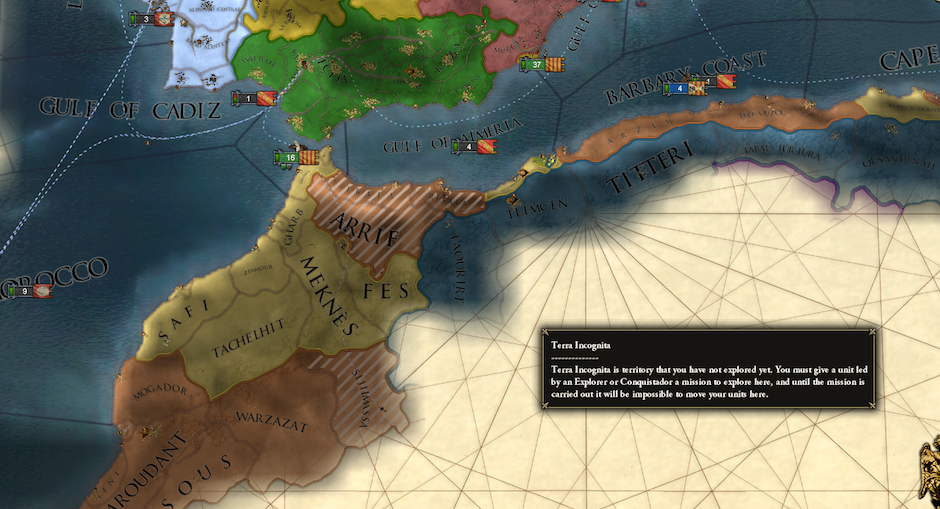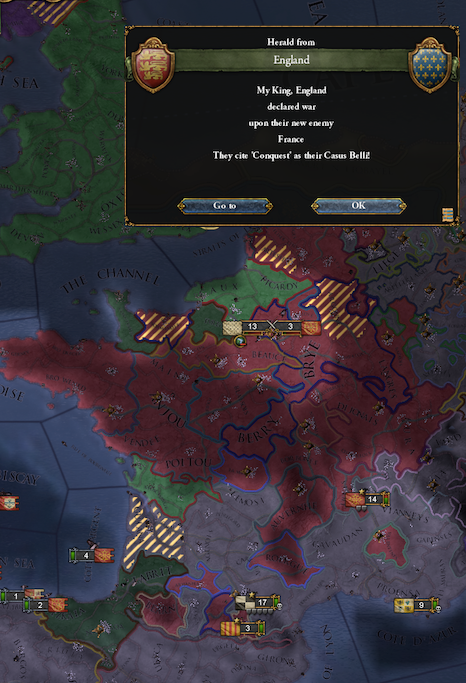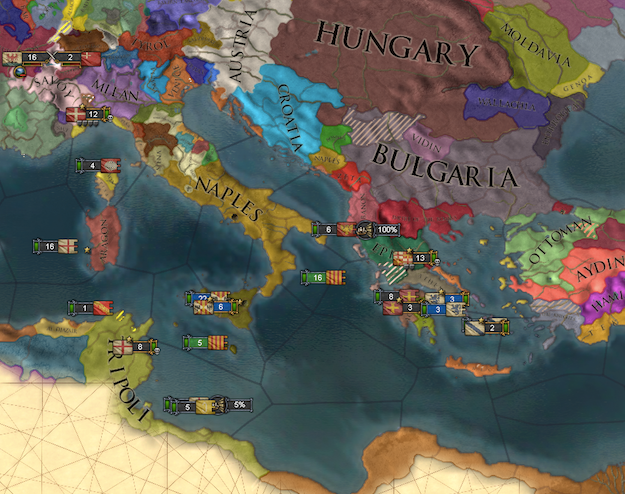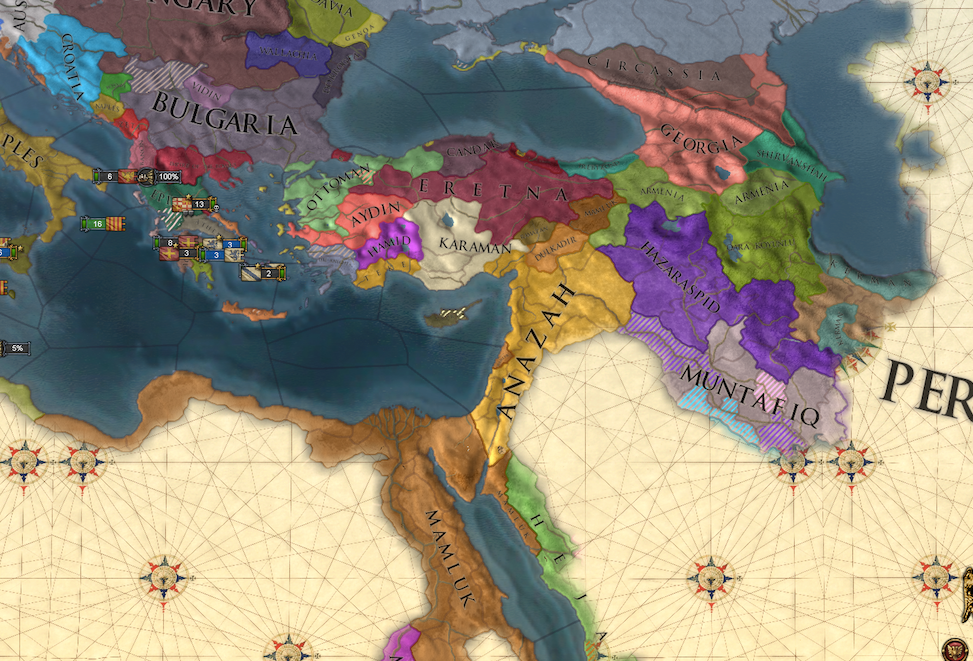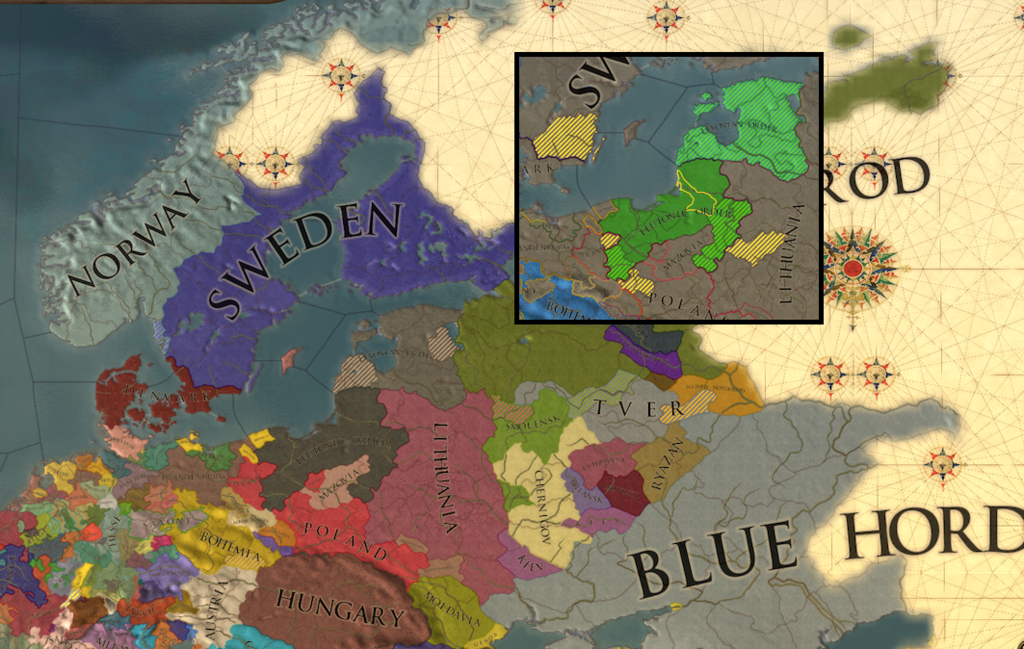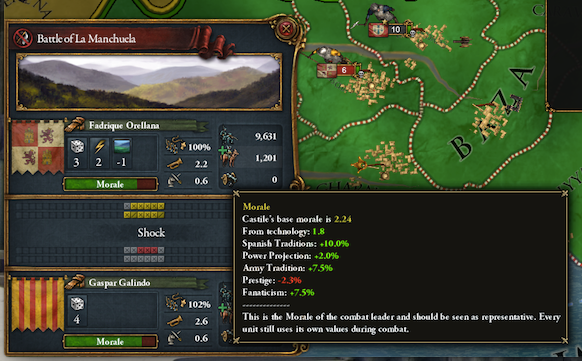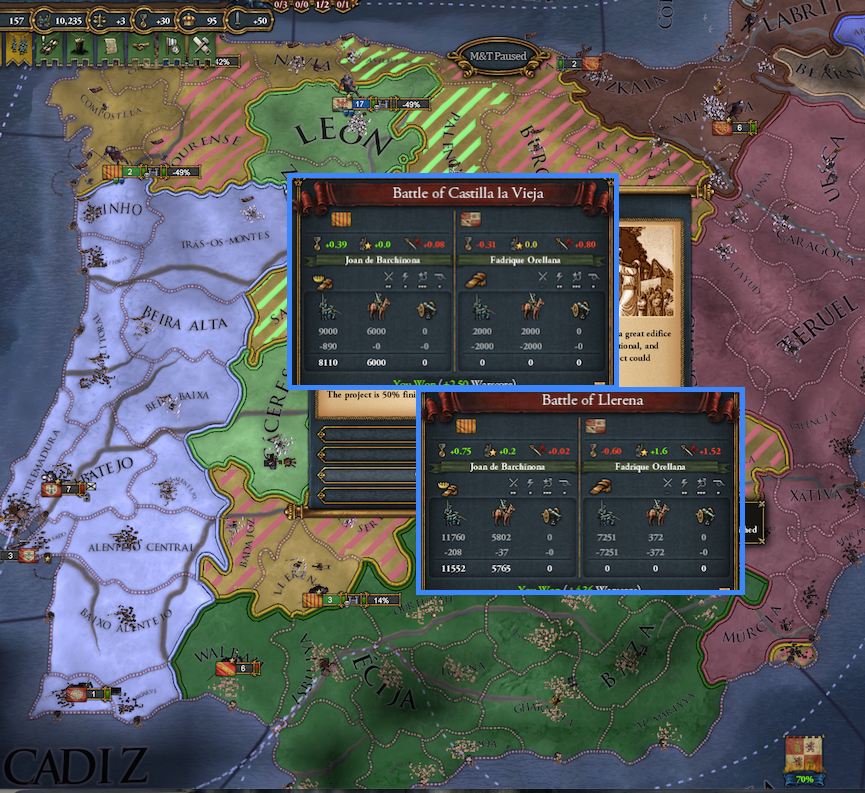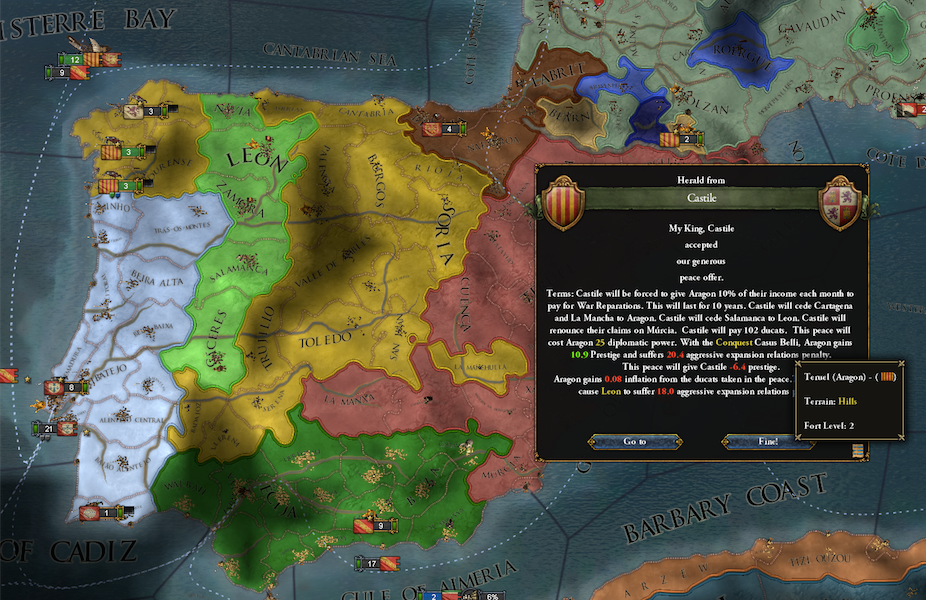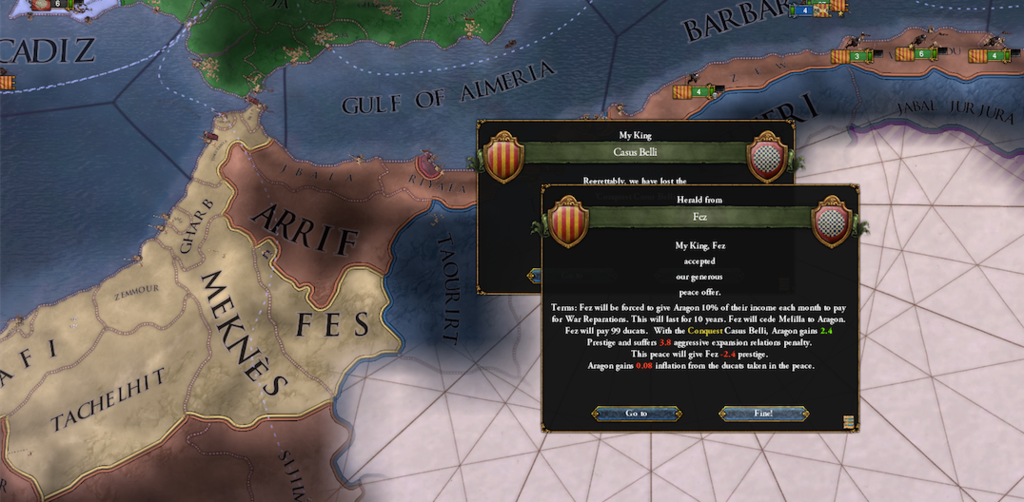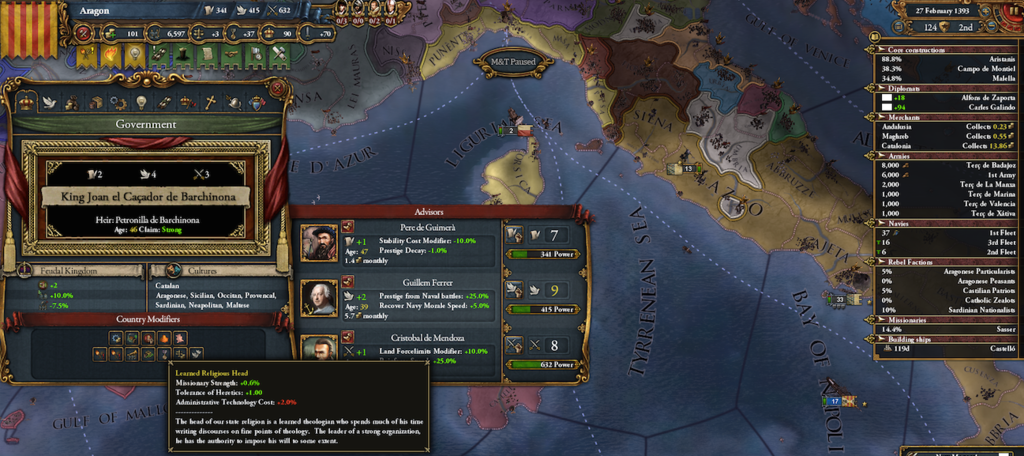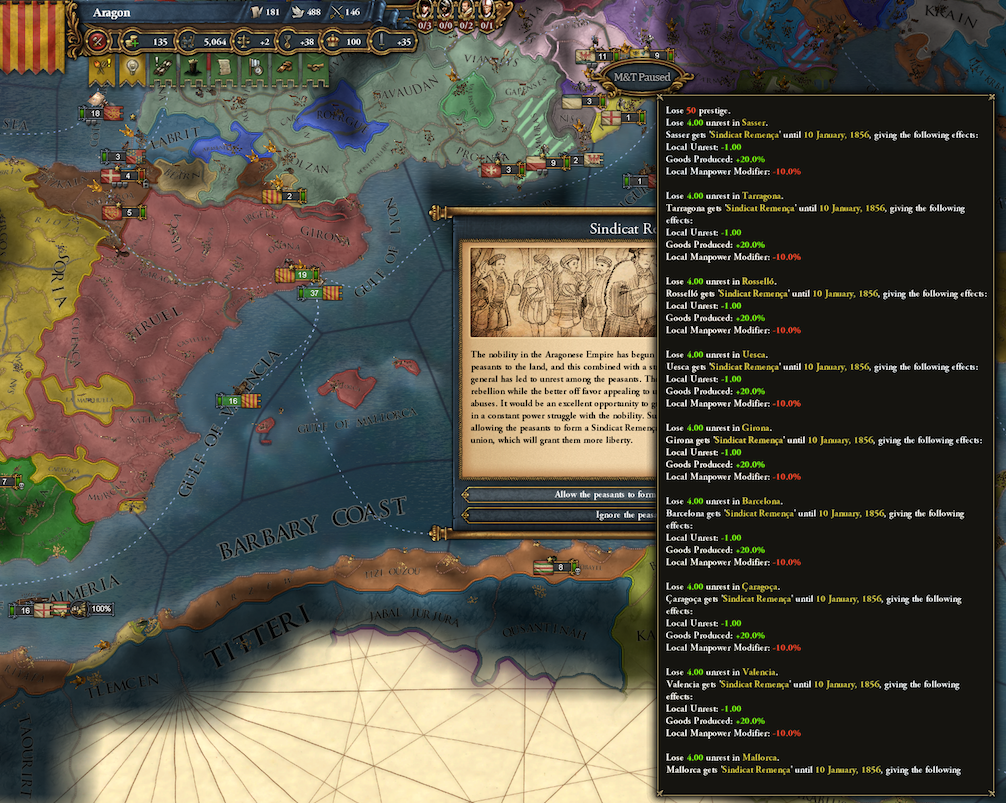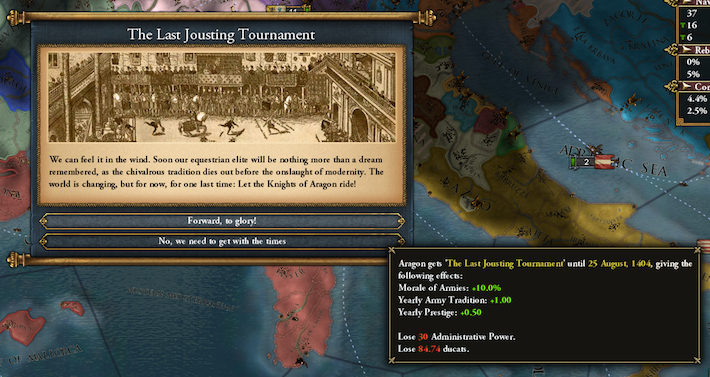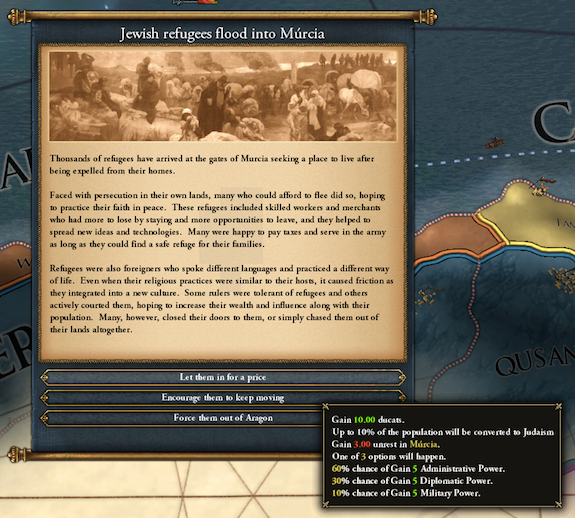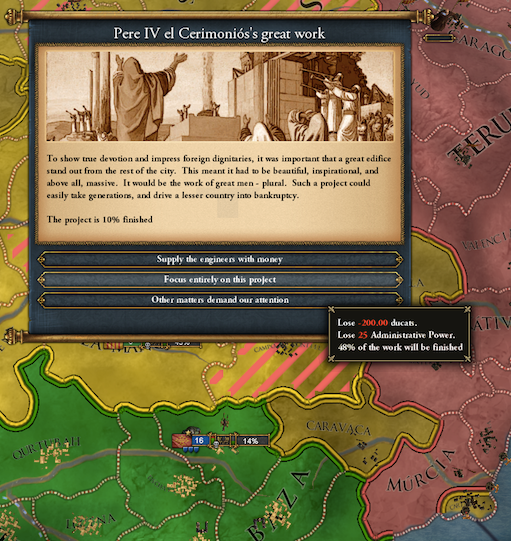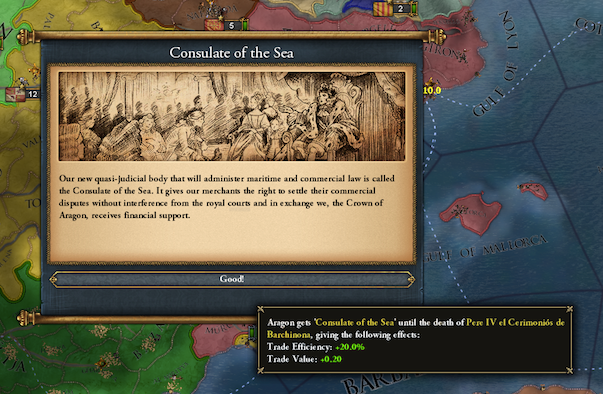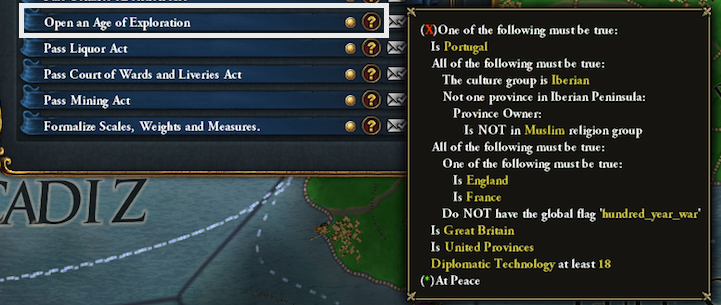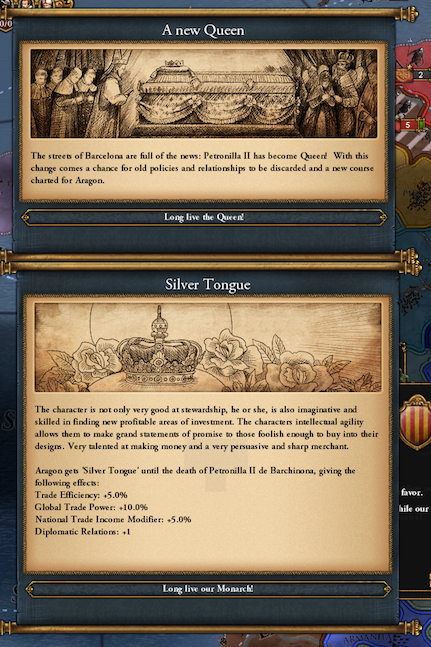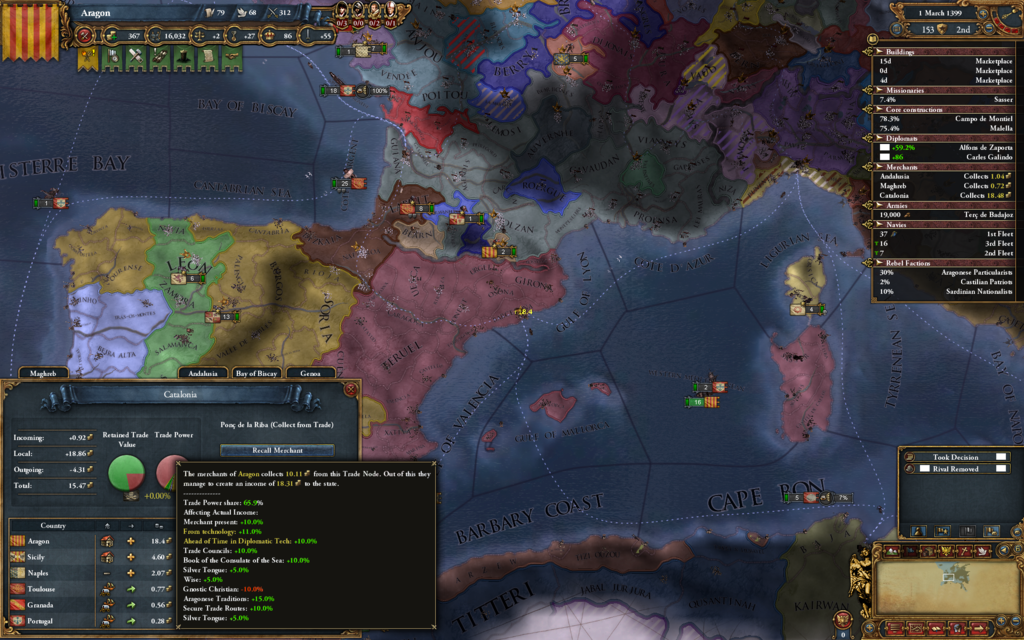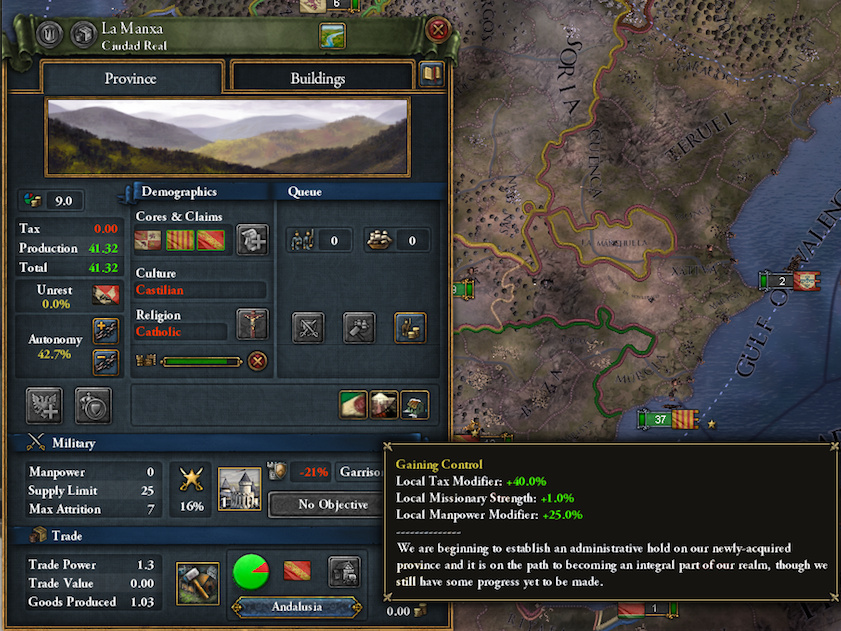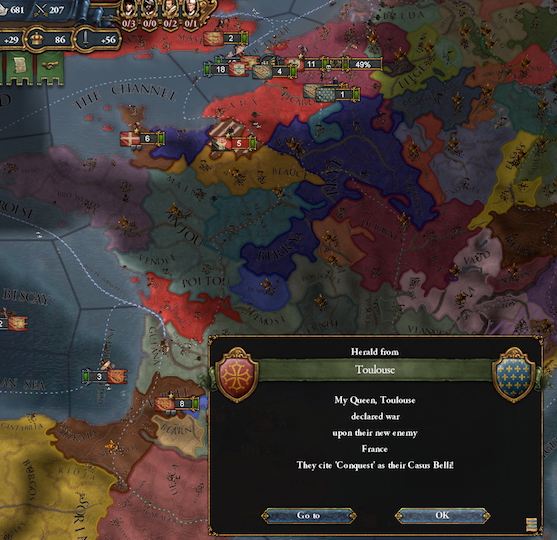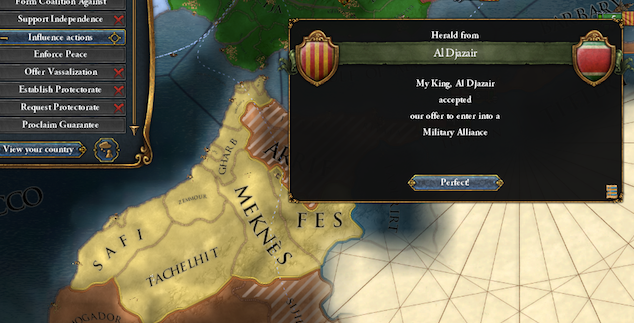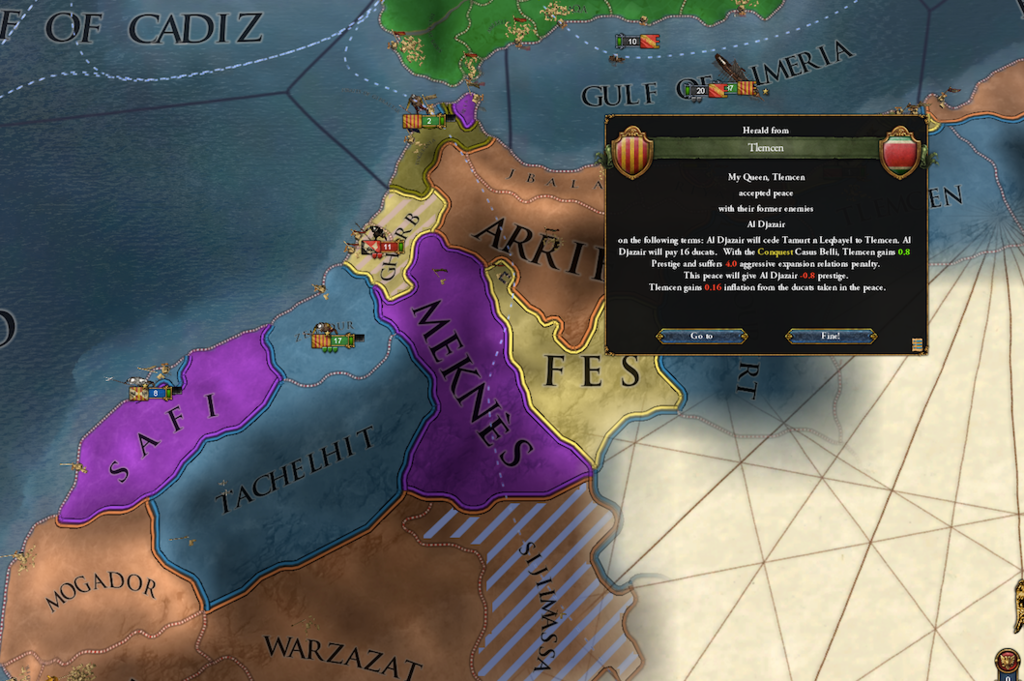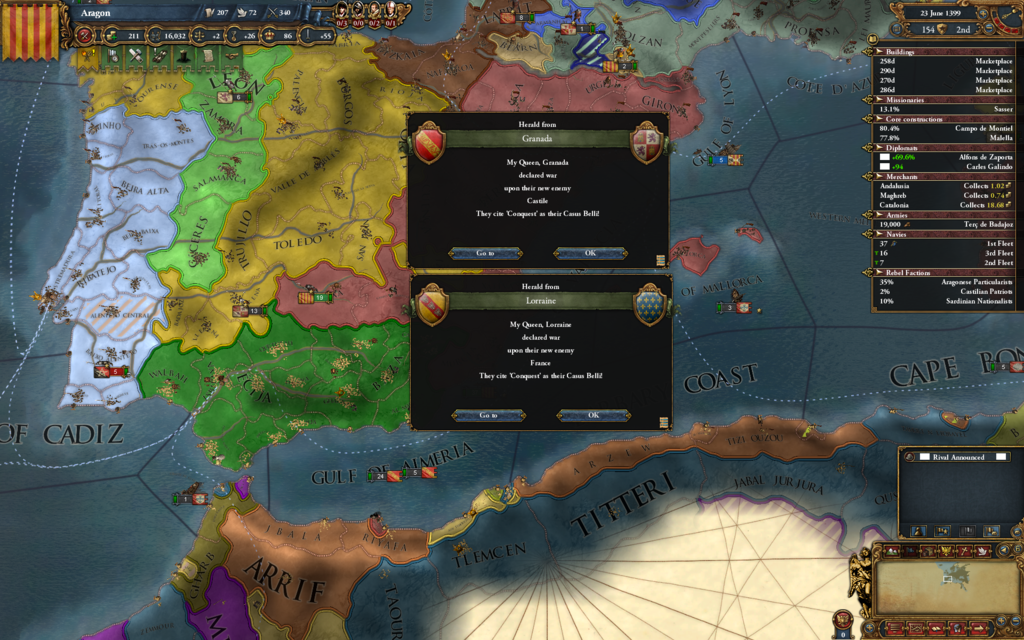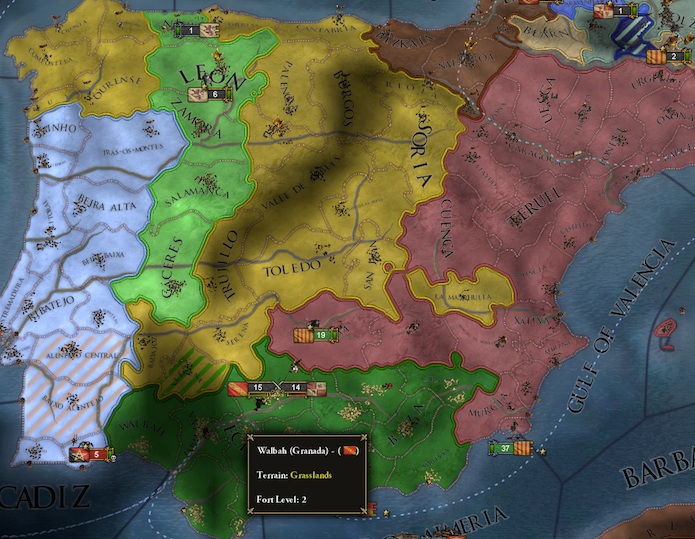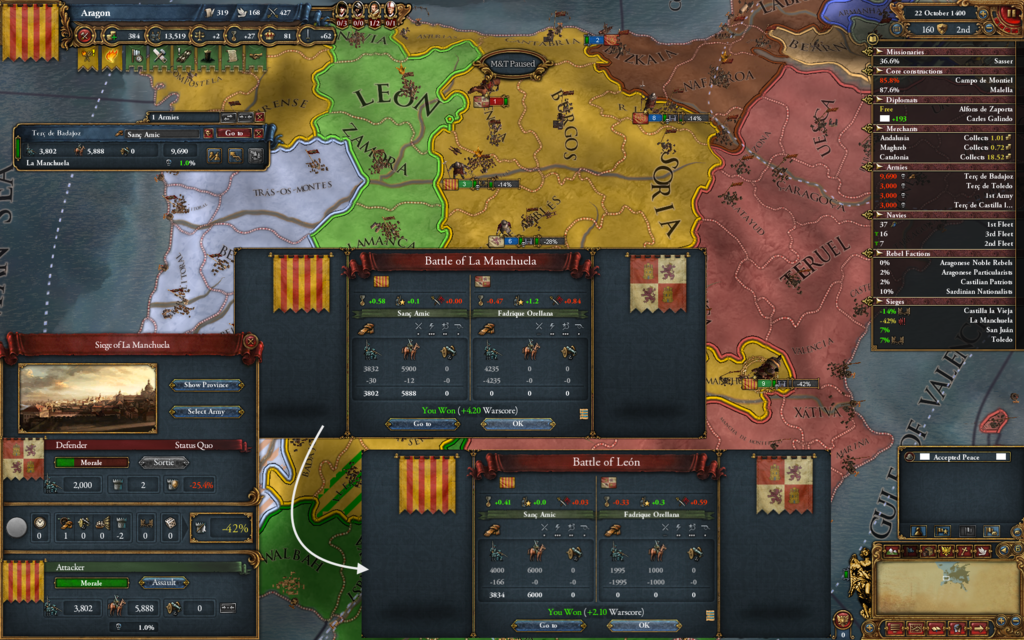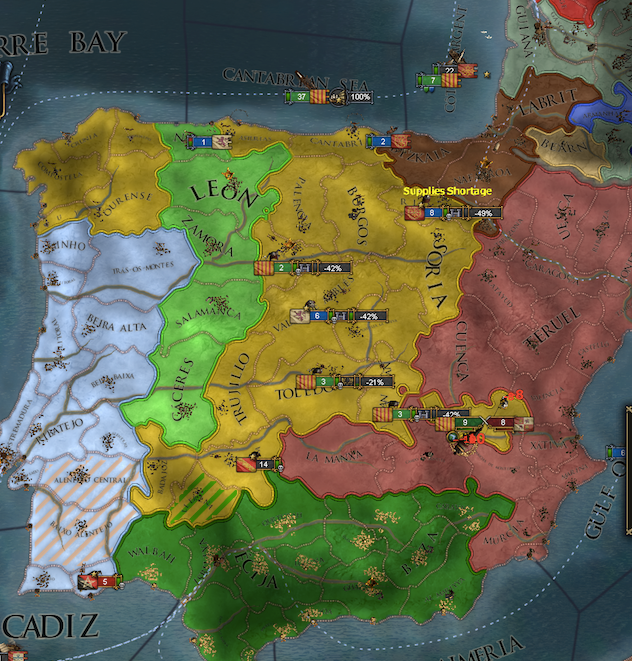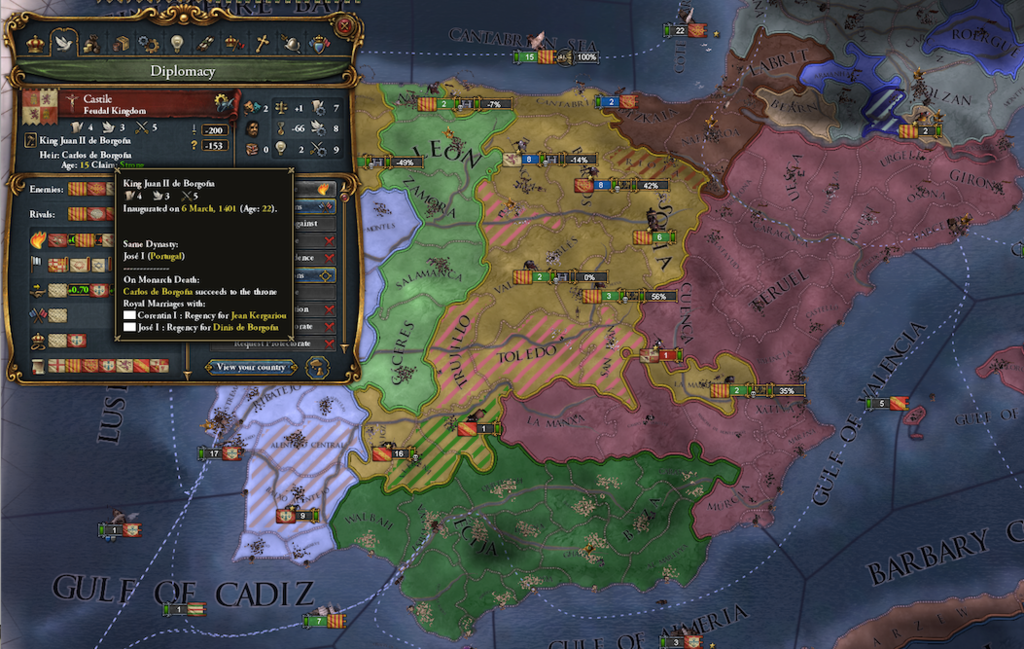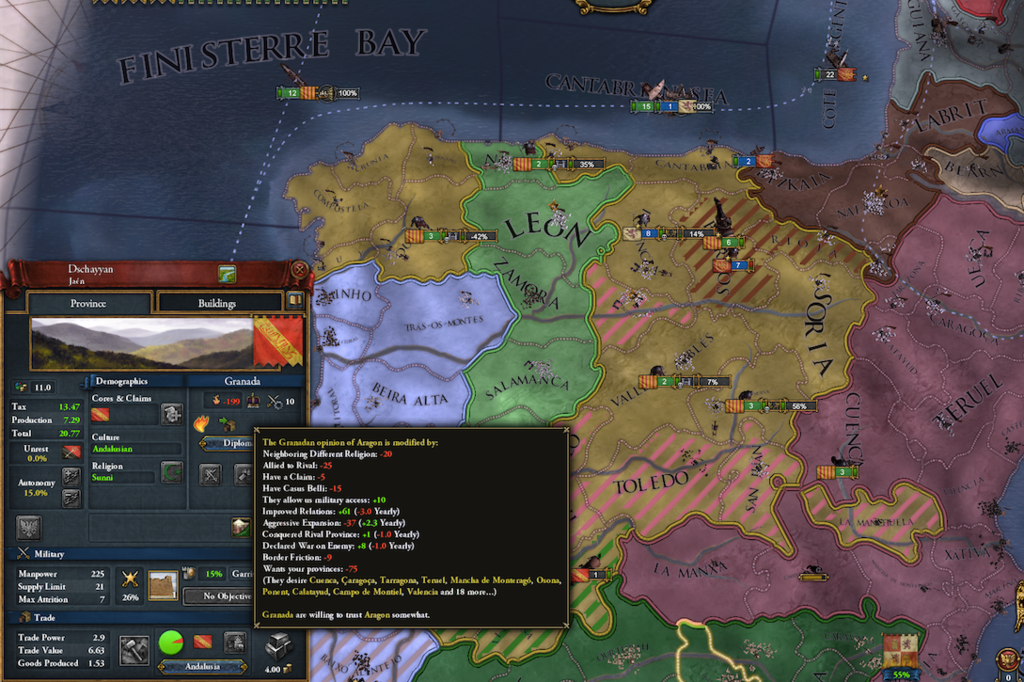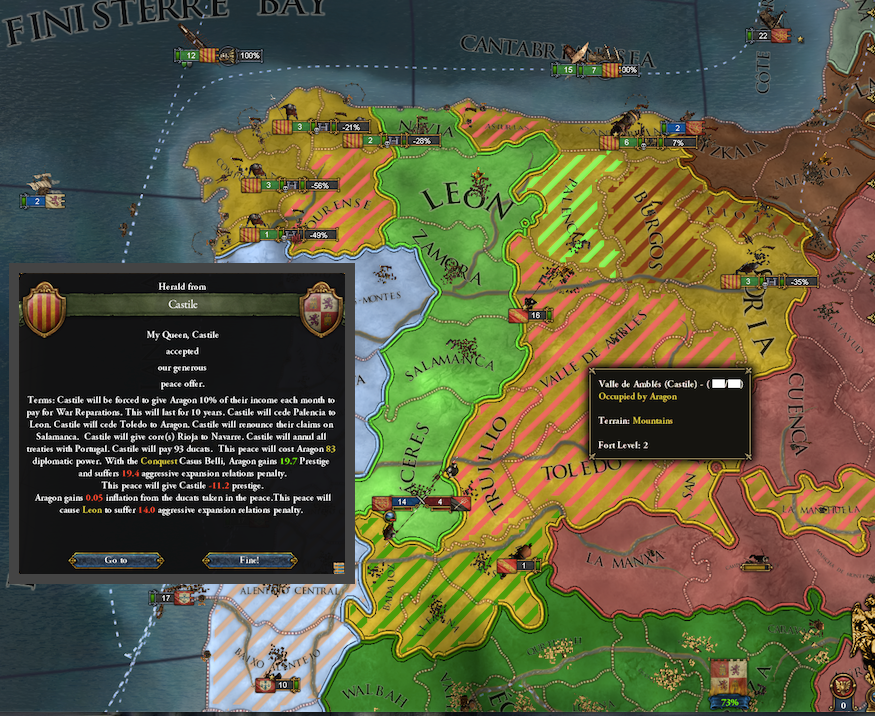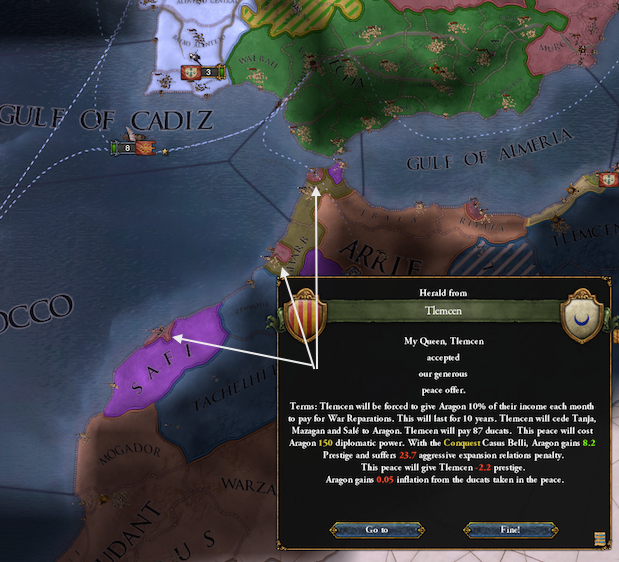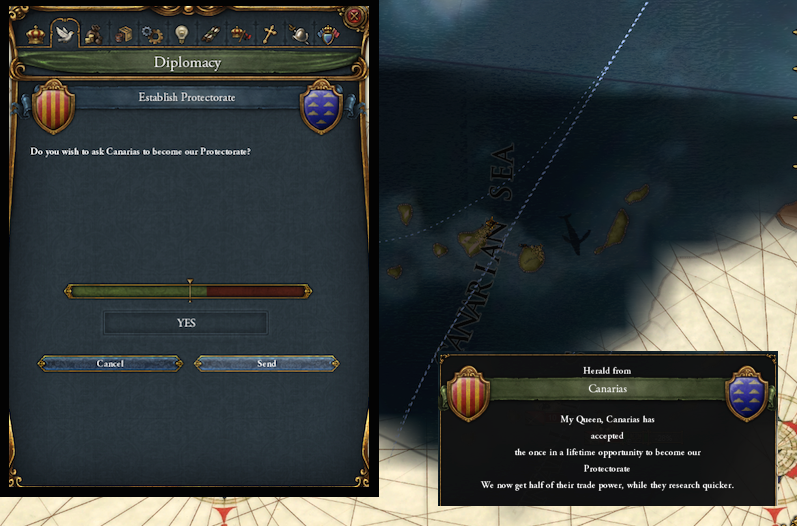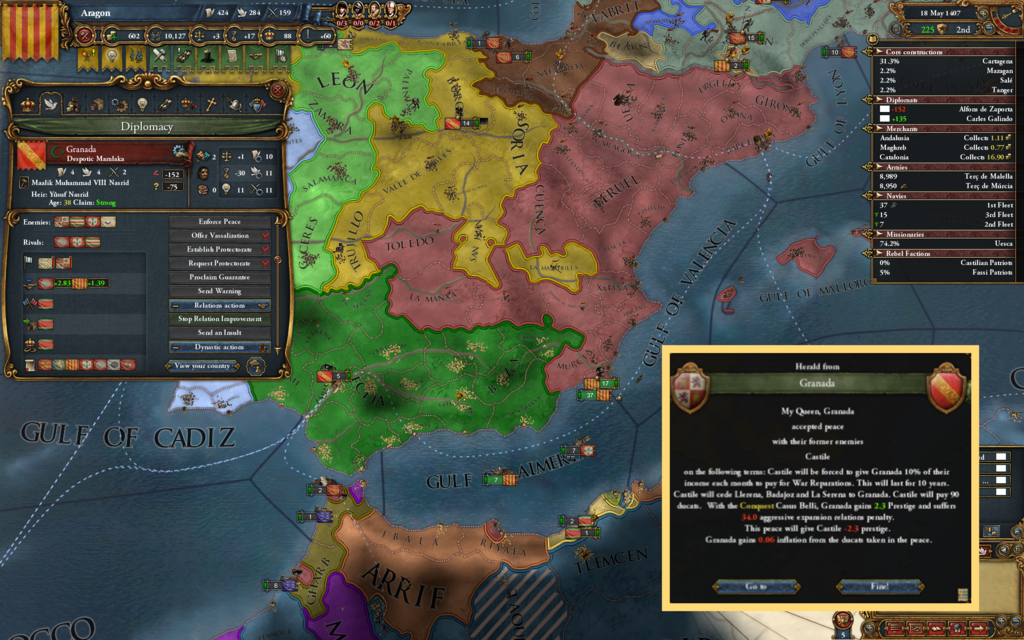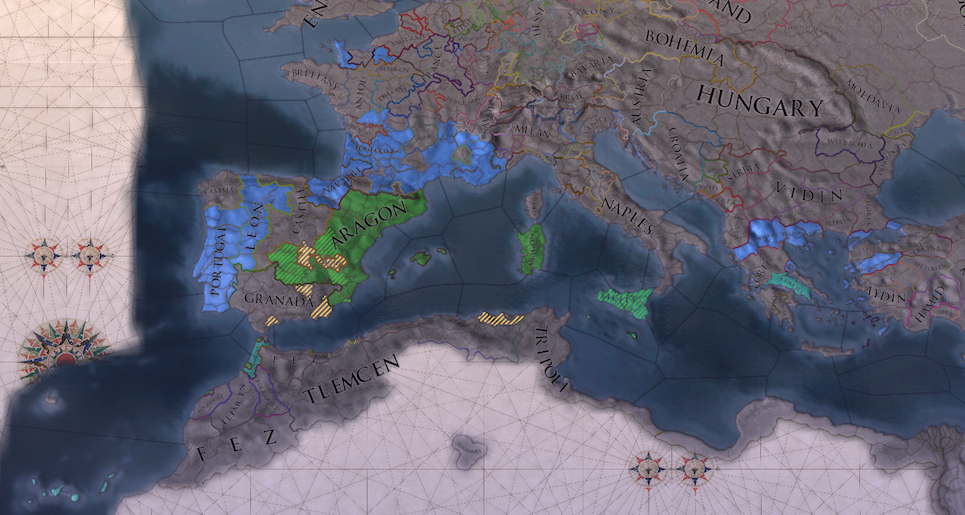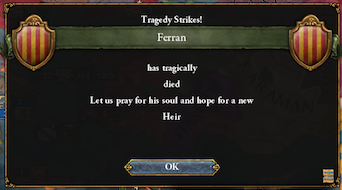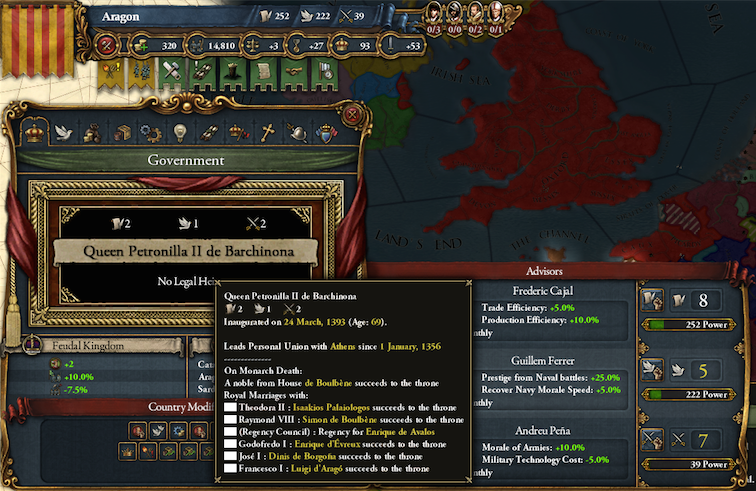Some Details:
I'll try to use a mix of Popular History, Scholarly History & Game Mechanics
Game Details:
EUIV 11.04 & DLCs: Art of War, Conquest of Paradise, El Dorado, Purple Phoenix, Star and Crescent, Wealth of Nations, Res Publica & Various Unit Packs
M&T 1.19 (and all M&T related items in the Steam Workshop) and Fantasy Religious Options chosen (more on that in the intro below)
No Lucky Nations, Hard AI
Goals:
This is really a game meant to explore how M&T works. I started a game as Granada, and I got seriously beat down! So I decided to try a slightly more powerful starting nation, and then observe how the game dealt with those other, smaller nations.
Within that general rule (and as you probably guessed from the Title of this AAR, I’m intrigued to play Aragon as a trading nations, with roots in the histories of its component parts - Barcelona, Valencia, Mallorca and Medina, etc.) We’ll see where that takes us!
(Side note - I don’t have lots of time to play or write, so although I’m going to try to do as much as I can I might only show up once or twice a month…hopefully it won’t be so infrequent that people aren’t interested!)
THE MERCHANT KINGS OF ARAGON
Introduction
Europe as it exited the High Middle Ages was an interesting mix of polities, traditions (religious and otherwise), knowledge, hatred and rivalries, and alliances (opportunistic as well as strategic.) Among this melange of potential topics, this history (written, I hope, for the everyday reader, but with perhaps a nod now and then to the scholar) will focus on what was then called the Crown of Aragon.
Let’s look quickly at the hodgepodge that was Europe at the time:
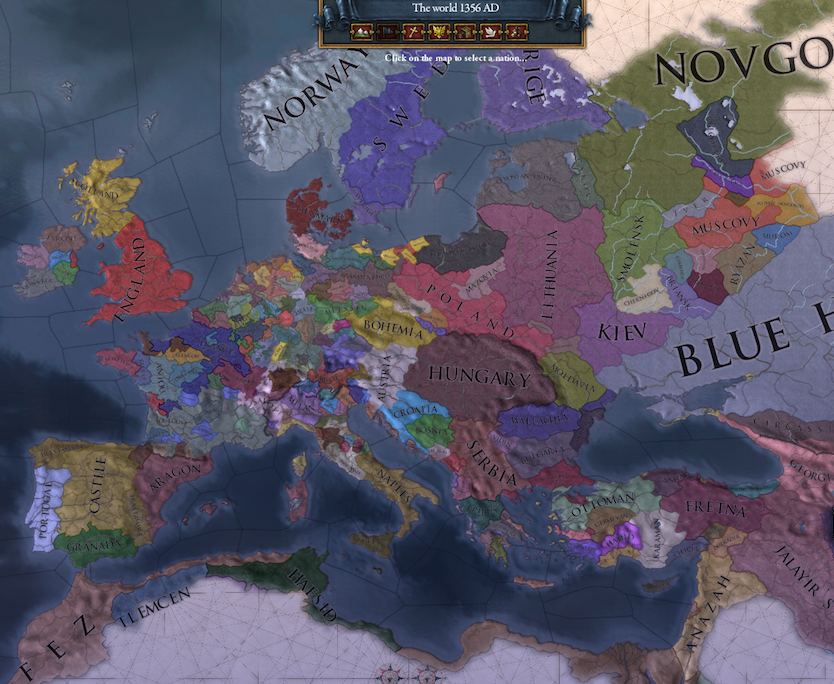
Around the edges, the states were starting coalesce into feudal or despotic states - not the nation states of today, but the porto-nation state of the day, ruled by dynasties (generally) or elites (noble or merchant, and much less often.) Thus, if we start in Scandinavia, we see the emergence in 1350 of the large states of Norway, Sweden and Denmark, and then the anomalous massive merchant Republic of Novgorod stretching into the unknown frozen tundra.
The steppes were occupied by Lithuania and the Blue Horde (a remnant of earlier Mongol Horde lands) as well as the smaller states between these behemoths. Poland, Hungary, and various Slavic lands populated the rest of Eastern Europe.
Around the edges of the Levant, large states continued tis trend all the way to the Atlantic coasts, with Fez (in particular) controlling the rich coastal enclaves and much of the hinterland. England, although not ready to surrender its territories in France, was larger confined to its island home, but was an excellent example of an emerging strong centralized state. And on Iberia, three very unequal kingdoms had extended their control across the entire peninsula. Portugal has managed to gain control of the Atlantic coast south of the ancient kingdom of Galicia, and was ruled by a cadet branch of the House of Burgundy. The same house has managed to unite Galicia with the kingdoms of Leon and Castile (taking the name of Castile), and although in 1350 a huge portion of the kingdom was controlled by the bastard son Henry of Trastamara) of a bastard lineage, Castile was rich and strong, and its primary vassal, the Emirate of Granada, was just as wealthy and possibly stronger, resting on it’s ancient Islamic foundations of science and knowledge.
Aragon was the last of these three Iberian players. More of this later, but unlike the Burgundian realms, Aragon was a formal (and highly decentralized) union of many kingdoms, principalities, duchies, counties, cities and territories. This unique nature is in fact why we will focus on the history of this unique place.
One last comment on the political nature of Europe in 1350 - although the peripheries were characterized (in most cases) by the slow emergence of large, strong states, the closer to the center you got, the most chaotic and fractionalized it became. In fact, the massive “state” at the heart of Europe (the Holy Roman Empire) was in fact an agglomeration of over 80 states - some large, some micro-states, but all competing for power, influence, wealth and a say in driving their own destinies. At the heart of this Empire-in-name was the Emperor, who also aspired to all of those goals along with the goal of keeping some semblance of power vested in himself.
Opposed to this chaotic political picture, the religious picture was more rational, but still presented an interesting mix of religious options.

A short description to discuss the major fault lines.
1. In most of Europe, Catholicism reigned supreme - but vast swaths of the Mediterranean cost outside of Italy were governed by states and people adhering to the Gnostic Christian confession (if it can be called that.)
2. The Orthodox Christian faith, once spread across much of the Eastern Roman Empire was a mere shadow of its previous self.
3. In Egypt, a unique local version of Christianity had reasserted itself, displacing both the Orthodox region of the Romans and the Islam of Arab conquerors.
4. And in the the fertile crescent, the Chaldean rite of Christianity (introduced by monks fleeing Imperial persecution) had converted the Mongol hordes who stayed after the destruction of the old Caliphate.
5. Further east, the Zoroastrians still ruled the lands of Persia.
6. Unlike their brothers in the Levant, most of the Mongol states still hued to their ancestral religions.
7. And finally, further north the ancient Viking religions still flourished, as did the pagan rites across the vast steppes.
The impact of all of these differences on the daily lives of the people was, of course, insignificant - most people in 1350 never left their village, much less crossed imaginary lines into other realms. But this religious variety played heavily in lives of many rulers of the period, and none more so that the men (and women) at the heart of the Crown of Aragon. In 1350 they ruled lands peopled by Gnostic Christians, Catholics, Orthodox, Jews and Muslims, and they faces rulers professing all of those faiths who could easily call upon the casus belli of religious oppression to invade the lands of the Crown. It made for interesting times for these rulers, and hopefully for us!
Aragon: A Short Backstory
Most of the history of the Crown of Aragon can be found in other books and resources (for example, here: https://en.wikipedia.org/wiki/Crown_of_Aragon), so let me just tease out a few key moments that will cycle through our story.
The key moment (I believe) in the formation of what would become the Crown of Aragon happened almost two centuries before our story begins. This was the marriage of Raymond Berenguer of Barcelona to Petronilla of Aragon in 1136. This brought the expansive coastal and merchants tendencies of the County/Principality of Barcelona under the Berenguers into union with the royal lands and titles of Aragon. This created a powerful state that spanned the Pyrenees, and one that was immediately in conflict with the kings of France (who used Crusades against the Cathars and other expression of Gnostic belief) and the various royal houses the ruled the kingdoms of Iberia (the Jimenez and then the Burgundians.)
We won’t recount the varied ups and downs of the House of Barcelona here (but please read the tales where you can find them!); we will say this - The Crown of Aragon was critical in the evolution of European polities. It was a hybrid, and evolutionary step away from pure Feudal kingdoms on the one hand, and the pure Merchant Republics on the other. It bound these two traditions together - at times closely, at other times less so, but always tried to find a balance between the authority of the dynasty and court and that of what can only be described as an emerging merchant and urban class. In fact, I’ve titled this study “The Merchant Kings of Aragon” for this exact reason - they wore both hats in their long history, and most of what her rulers did can be tied back to a need to stabilize the dynasty and foster the growth of merchant wealth and control across the Mediterranean and beyond.
~ ~ ~ ~ ~
Chapter 1
The Warrior Kings: Iberia at the close of the High Middle Ages
By 1350 the High Middle Ages (as we’ve come to call them) were waning. The various kingdoms, principalities, dukedoms and counties, as well as various Islamic taifas and successor states had resolved themselves into 3 major political spheres - Portugal, Castile and Aragon. And as mentioned, Castile itself was divided into three almost equal spheres: 1) the lands and town loyal to the House of Burgundy, 2) the nobles and their territories loyal to Henry Trastamara (the half-brother of the king) and 3) the still wealthy remnants of the Muslim states, centered on Granada.
The King of Aragon, Pere IV, had inherited the animosity of his dynasty and state to the House of Burgundy and the realms that made up Castile. Both realms had jousted for dominance over Iberia during the initial phases of the Reconquest, and Aragon had lost the majority of those battles. In some cases that hostility broke into open warfare; at other times it manifested itself in low-level hostilities. The rise of Henry of Trastamara introduced a new weapon to fight against Castile. Pere IV actively gave support to Henry, up to and including support for outright independence from Castile for the lands he controlled. We’ll see that this is the last thing that Henry actually wanted, but he was willing to accept the friendship and support (moral as well as financial) from the King of Aragon.
Indeed when our story begins, the two Peters are locked in a low level conflict, which most of the battles (and near misses) taking place in the mountains of western Aragon, and the hill country of lower Castile. Neither side could comprehensively defeat the other - both sides often withdrew their armies deeper into the heart of their respective countries to recover from a loss, or a win that was almost as demoralizing as a win. The active support given to Henry and to the Emir of Granada ensure both of those Castilian vassals failed to support the overlord with help that could have conclusively tipped the scales in favor or Aragon.
By 1379, however, Henry’s partisans began to rebel against the king of Castile in earnest, and Peter was compelled to split his attention between the Aragonese and the supporters of Trastamara. This allowed Pere IV to besiege the important silver mines of Badajoz and some of the surrounding territory.
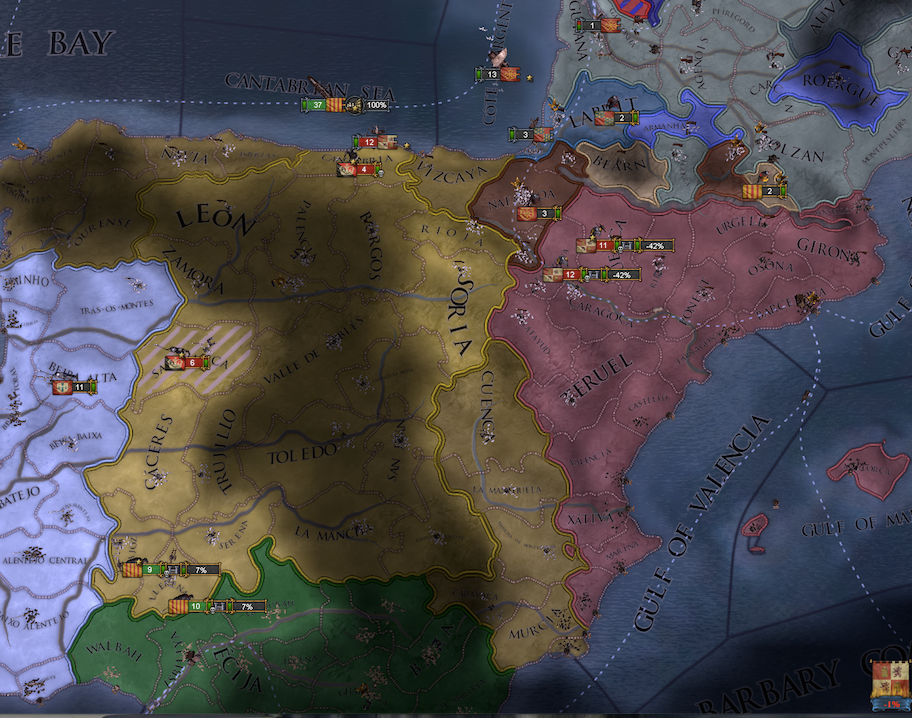
As the year progressed, the revolts by Henry’s supporters grow more severe, and Pere IV was able to capture the mines and other castles and towns, bringing in much welcome spoils of war.
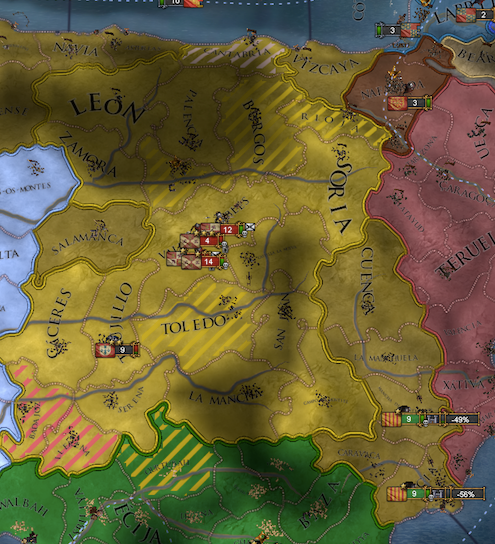
This culminated in 1360 with the formal rebellion of Henry against Peter of Castile in 1360. By this time many provinces were already held by rebellious nobles in league with Henry; they now openly declared their allegiance and formally entered the war against the Castilian king.

Facing an impossible situation, Peter of Castile implored the pope to send scholars to Pere’s court in Barcelona to negotiate peace. Witnessing the speed with which Trastamara was overwhelming Peter, Pere agreed to a peace with no land or money changing sides.
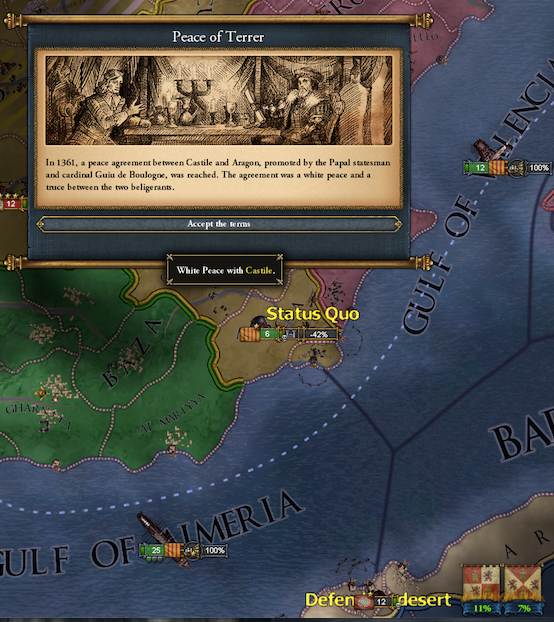
Some scholars have wondered why Pere, a Gnostic Christian with no particular allegiance to the Pope would accept such a peace after many years and possession of the rich mines in Badajoz. I believe the answer is quite simple - leaving aside the fact that the mines in Badajoz were far from the territory of Aragon, and would have been impossible to administer, the Aragonese policy had long been to keep the Castilian divided within their kingdom, and so less of a threat to the Crown of Aragon. The speed with which Trastamara was overthrowing the power of Peter of Castile must have alarmed Pere, and threatened to replace a weak and divided nation with one under a strong king who would be better able to marshal his forces for an assault on Aragon. And so just as he had supported Henry when he was the underdog, now he allowed Peter to escape the consequences of a long war in order to fight back against the usurping Henry. In support of this strategy (and sensing an opportunity to gather back to Aragon lands long-claimed by the Crown but held by Trastamara), Pere IV formally declared war on Trastamara.
Who knows what would have happened if Peter had focused all his attention on Henry and the rebellious nobles that flocked to his standard in ever-increasing numbers? Particularly with the forces of Portugal, Granada and now Aragon arrayed on his side. We, of course, will never know because less than a year after signing the papal peace with Aragon Peter declared war on Aragon, breaking the peace, sending even his most staunch supporters into shock, and bringing his own name and the legitimacy of his his dynasty and state to previously unknown depths.
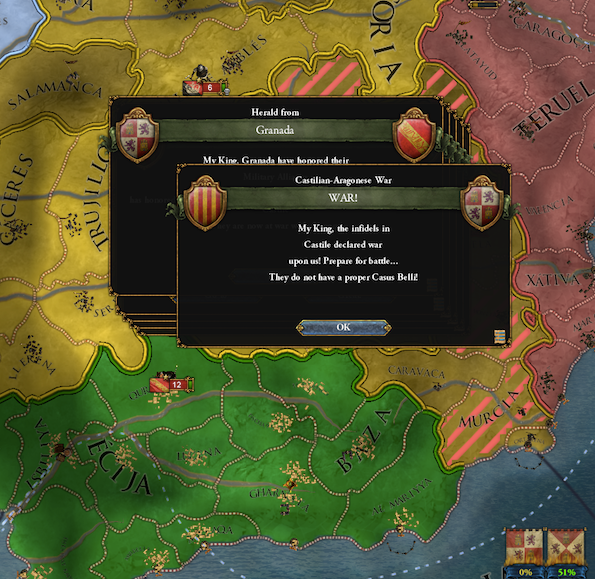
By 1363, Henry was facing defeats on all fronts. In order to preserve his territory and continue to conspire against Peter of Castile, he agreed to a peace with all parties. The peace with Aragon granted the counties of Murcia (long contested between the two realms) and two other provinces on the high plateau of central Castile.
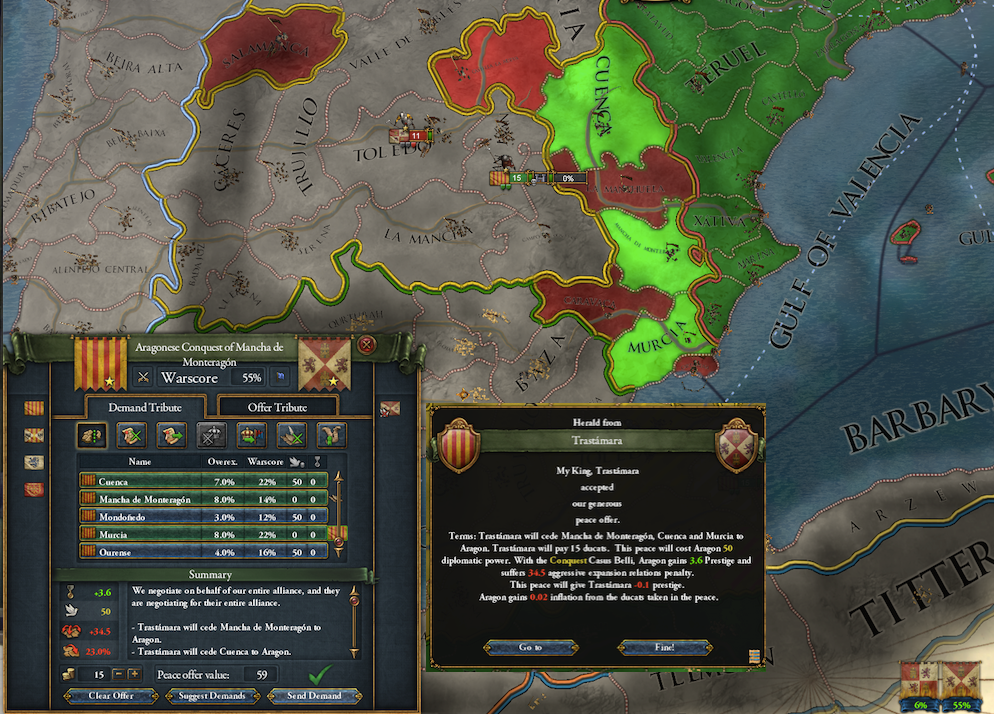
Portugal received nothing from that peace - her Kings were outraged and the slight from Peter (one of a litany of slights that contributed to significantly to his current precarious situation) and thus at the urging of the King of Aragon, joined the war against Castile alongside Aragon and Toulouse.
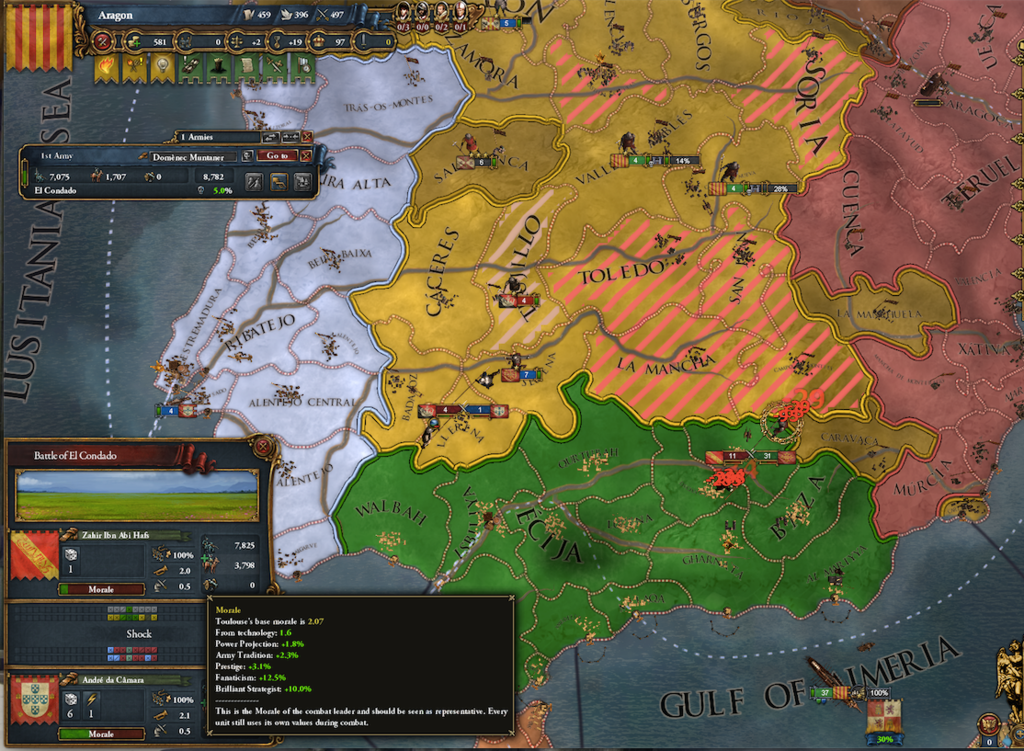
It took the Grand Coalition three years, but by 1368 Peter was completely defeated, with most of his lands under the control of Aragon. Peter agreed to cede one province to Aragon; more importantly he agreed to renounce his major claim in Granada and to release the ancient kingdom of Leon.

And within days, Henry’s partisans had taken Peter of Castile and his infant daughter into captivity (and most likely death) and given the throne to the House of Trastamara - the very outcome Pere IV had so assiduously tried to avoid.
However, although the nobles of Castile had generally supported Henry (and thus the ease of his acquisition of the throne), Peter had long been the favorite of the peasants and merchant classes. His disappearance and the rumors of his death caused immense unrest in the countryside. Within a two years of ascending the throne, Henry himself faced massive unrest of rebellion in the countryside.

In 1378, after much cajoling by various ambassadors from Aragon and the North African emirates, Granada declared independence from Castile and the Trastamaras. Granada was at this time an extremely wealthy and advanced Emirate based in the mountains of Granada, but extending over the rich plains to the east, and included Seville and Cadiz. It was at least as wealthy as Castile, particularly a Castile bereft of Leon and mired in debt and unrest. It was also somewhat more advanced that its overlord, which made its armies and navies more than a match for the demoralized and ill equipped Castilian forces.
Pere IV saw a chance to further Aragonese aims and claims against the ancient enemy. War was duly declared and the armies of Aragon, Leon and Toulouse marched into the Iberian heartland, where they cleverly chose to battle with the bruised and weakened armies of Trastamara. In the midst of this war, the king and his heir, his brother Joan, were struck with a fatal disease. Joan survived, Pere did not. After leading his country for 44 years, Pere IV passed away in Barcelona, and was succeeded on the throne by his brother, Joan.
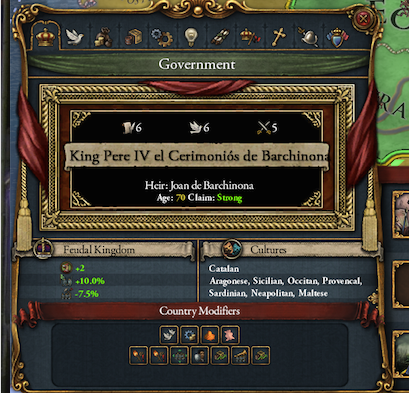
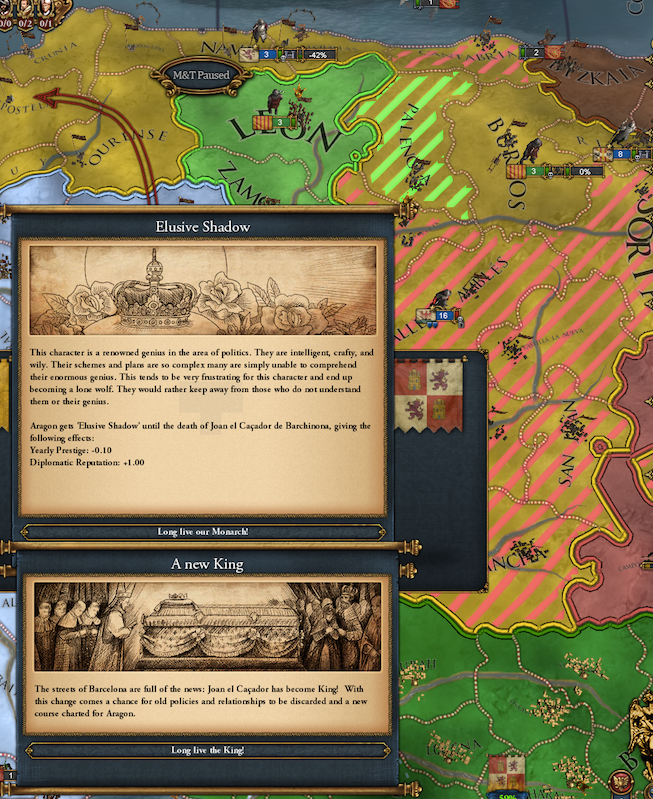
***
I'll try to use a mix of Popular History, Scholarly History & Game Mechanics
Game Details:
EUIV 11.04 & DLCs: Art of War, Conquest of Paradise, El Dorado, Purple Phoenix, Star and Crescent, Wealth of Nations, Res Publica & Various Unit Packs
M&T 1.19 (and all M&T related items in the Steam Workshop) and Fantasy Religious Options chosen (more on that in the intro below)
No Lucky Nations, Hard AI
Goals:
This is really a game meant to explore how M&T works. I started a game as Granada, and I got seriously beat down! So I decided to try a slightly more powerful starting nation, and then observe how the game dealt with those other, smaller nations.
Within that general rule (and as you probably guessed from the Title of this AAR, I’m intrigued to play Aragon as a trading nations, with roots in the histories of its component parts - Barcelona, Valencia, Mallorca and Medina, etc.) We’ll see where that takes us!
(Side note - I don’t have lots of time to play or write, so although I’m going to try to do as much as I can I might only show up once or twice a month…hopefully it won’t be so infrequent that people aren’t interested!)
THE MERCHANT KINGS OF ARAGON
Introduction
Europe as it exited the High Middle Ages was an interesting mix of polities, traditions (religious and otherwise), knowledge, hatred and rivalries, and alliances (opportunistic as well as strategic.) Among this melange of potential topics, this history (written, I hope, for the everyday reader, but with perhaps a nod now and then to the scholar) will focus on what was then called the Crown of Aragon.
Let’s look quickly at the hodgepodge that was Europe at the time:

Around the edges, the states were starting coalesce into feudal or despotic states - not the nation states of today, but the porto-nation state of the day, ruled by dynasties (generally) or elites (noble or merchant, and much less often.) Thus, if we start in Scandinavia, we see the emergence in 1350 of the large states of Norway, Sweden and Denmark, and then the anomalous massive merchant Republic of Novgorod stretching into the unknown frozen tundra.
The steppes were occupied by Lithuania and the Blue Horde (a remnant of earlier Mongol Horde lands) as well as the smaller states between these behemoths. Poland, Hungary, and various Slavic lands populated the rest of Eastern Europe.
Around the edges of the Levant, large states continued tis trend all the way to the Atlantic coasts, with Fez (in particular) controlling the rich coastal enclaves and much of the hinterland. England, although not ready to surrender its territories in France, was larger confined to its island home, but was an excellent example of an emerging strong centralized state. And on Iberia, three very unequal kingdoms had extended their control across the entire peninsula. Portugal has managed to gain control of the Atlantic coast south of the ancient kingdom of Galicia, and was ruled by a cadet branch of the House of Burgundy. The same house has managed to unite Galicia with the kingdoms of Leon and Castile (taking the name of Castile), and although in 1350 a huge portion of the kingdom was controlled by the bastard son Henry of Trastamara) of a bastard lineage, Castile was rich and strong, and its primary vassal, the Emirate of Granada, was just as wealthy and possibly stronger, resting on it’s ancient Islamic foundations of science and knowledge.
Aragon was the last of these three Iberian players. More of this later, but unlike the Burgundian realms, Aragon was a formal (and highly decentralized) union of many kingdoms, principalities, duchies, counties, cities and territories. This unique nature is in fact why we will focus on the history of this unique place.
One last comment on the political nature of Europe in 1350 - although the peripheries were characterized (in most cases) by the slow emergence of large, strong states, the closer to the center you got, the most chaotic and fractionalized it became. In fact, the massive “state” at the heart of Europe (the Holy Roman Empire) was in fact an agglomeration of over 80 states - some large, some micro-states, but all competing for power, influence, wealth and a say in driving their own destinies. At the heart of this Empire-in-name was the Emperor, who also aspired to all of those goals along with the goal of keeping some semblance of power vested in himself.
Opposed to this chaotic political picture, the religious picture was more rational, but still presented an interesting mix of religious options.

A short description to discuss the major fault lines.
1. In most of Europe, Catholicism reigned supreme - but vast swaths of the Mediterranean cost outside of Italy were governed by states and people adhering to the Gnostic Christian confession (if it can be called that.)
2. The Orthodox Christian faith, once spread across much of the Eastern Roman Empire was a mere shadow of its previous self.
3. In Egypt, a unique local version of Christianity had reasserted itself, displacing both the Orthodox region of the Romans and the Islam of Arab conquerors.
4. And in the the fertile crescent, the Chaldean rite of Christianity (introduced by monks fleeing Imperial persecution) had converted the Mongol hordes who stayed after the destruction of the old Caliphate.
5. Further east, the Zoroastrians still ruled the lands of Persia.
6. Unlike their brothers in the Levant, most of the Mongol states still hued to their ancestral religions.
7. And finally, further north the ancient Viking religions still flourished, as did the pagan rites across the vast steppes.
The impact of all of these differences on the daily lives of the people was, of course, insignificant - most people in 1350 never left their village, much less crossed imaginary lines into other realms. But this religious variety played heavily in lives of many rulers of the period, and none more so that the men (and women) at the heart of the Crown of Aragon. In 1350 they ruled lands peopled by Gnostic Christians, Catholics, Orthodox, Jews and Muslims, and they faces rulers professing all of those faiths who could easily call upon the casus belli of religious oppression to invade the lands of the Crown. It made for interesting times for these rulers, and hopefully for us!
Aragon: A Short Backstory
Most of the history of the Crown of Aragon can be found in other books and resources (for example, here: https://en.wikipedia.org/wiki/Crown_of_Aragon), so let me just tease out a few key moments that will cycle through our story.
The key moment (I believe) in the formation of what would become the Crown of Aragon happened almost two centuries before our story begins. This was the marriage of Raymond Berenguer of Barcelona to Petronilla of Aragon in 1136. This brought the expansive coastal and merchants tendencies of the County/Principality of Barcelona under the Berenguers into union with the royal lands and titles of Aragon. This created a powerful state that spanned the Pyrenees, and one that was immediately in conflict with the kings of France (who used Crusades against the Cathars and other expression of Gnostic belief) and the various royal houses the ruled the kingdoms of Iberia (the Jimenez and then the Burgundians.)
We won’t recount the varied ups and downs of the House of Barcelona here (but please read the tales where you can find them!); we will say this - The Crown of Aragon was critical in the evolution of European polities. It was a hybrid, and evolutionary step away from pure Feudal kingdoms on the one hand, and the pure Merchant Republics on the other. It bound these two traditions together - at times closely, at other times less so, but always tried to find a balance between the authority of the dynasty and court and that of what can only be described as an emerging merchant and urban class. In fact, I’ve titled this study “The Merchant Kings of Aragon” for this exact reason - they wore both hats in their long history, and most of what her rulers did can be tied back to a need to stabilize the dynasty and foster the growth of merchant wealth and control across the Mediterranean and beyond.
~ ~ ~ ~ ~
Chapter 1
The Warrior Kings: Iberia at the close of the High Middle Ages
By 1350 the High Middle Ages (as we’ve come to call them) were waning. The various kingdoms, principalities, dukedoms and counties, as well as various Islamic taifas and successor states had resolved themselves into 3 major political spheres - Portugal, Castile and Aragon. And as mentioned, Castile itself was divided into three almost equal spheres: 1) the lands and town loyal to the House of Burgundy, 2) the nobles and their territories loyal to Henry Trastamara (the half-brother of the king) and 3) the still wealthy remnants of the Muslim states, centered on Granada.
The King of Aragon, Pere IV, had inherited the animosity of his dynasty and state to the House of Burgundy and the realms that made up Castile. Both realms had jousted for dominance over Iberia during the initial phases of the Reconquest, and Aragon had lost the majority of those battles. In some cases that hostility broke into open warfare; at other times it manifested itself in low-level hostilities. The rise of Henry of Trastamara introduced a new weapon to fight against Castile. Pere IV actively gave support to Henry, up to and including support for outright independence from Castile for the lands he controlled. We’ll see that this is the last thing that Henry actually wanted, but he was willing to accept the friendship and support (moral as well as financial) from the King of Aragon.
Indeed when our story begins, the two Peters are locked in a low level conflict, which most of the battles (and near misses) taking place in the mountains of western Aragon, and the hill country of lower Castile. Neither side could comprehensively defeat the other - both sides often withdrew their armies deeper into the heart of their respective countries to recover from a loss, or a win that was almost as demoralizing as a win. The active support given to Henry and to the Emir of Granada ensure both of those Castilian vassals failed to support the overlord with help that could have conclusively tipped the scales in favor or Aragon.
By 1379, however, Henry’s partisans began to rebel against the king of Castile in earnest, and Peter was compelled to split his attention between the Aragonese and the supporters of Trastamara. This allowed Pere IV to besiege the important silver mines of Badajoz and some of the surrounding territory.

As the year progressed, the revolts by Henry’s supporters grow more severe, and Pere IV was able to capture the mines and other castles and towns, bringing in much welcome spoils of war.

This culminated in 1360 with the formal rebellion of Henry against Peter of Castile in 1360. By this time many provinces were already held by rebellious nobles in league with Henry; they now openly declared their allegiance and formally entered the war against the Castilian king.

Facing an impossible situation, Peter of Castile implored the pope to send scholars to Pere’s court in Barcelona to negotiate peace. Witnessing the speed with which Trastamara was overwhelming Peter, Pere agreed to a peace with no land or money changing sides.

Some scholars have wondered why Pere, a Gnostic Christian with no particular allegiance to the Pope would accept such a peace after many years and possession of the rich mines in Badajoz. I believe the answer is quite simple - leaving aside the fact that the mines in Badajoz were far from the territory of Aragon, and would have been impossible to administer, the Aragonese policy had long been to keep the Castilian divided within their kingdom, and so less of a threat to the Crown of Aragon. The speed with which Trastamara was overthrowing the power of Peter of Castile must have alarmed Pere, and threatened to replace a weak and divided nation with one under a strong king who would be better able to marshal his forces for an assault on Aragon. And so just as he had supported Henry when he was the underdog, now he allowed Peter to escape the consequences of a long war in order to fight back against the usurping Henry. In support of this strategy (and sensing an opportunity to gather back to Aragon lands long-claimed by the Crown but held by Trastamara), Pere IV formally declared war on Trastamara.
Who knows what would have happened if Peter had focused all his attention on Henry and the rebellious nobles that flocked to his standard in ever-increasing numbers? Particularly with the forces of Portugal, Granada and now Aragon arrayed on his side. We, of course, will never know because less than a year after signing the papal peace with Aragon Peter declared war on Aragon, breaking the peace, sending even his most staunch supporters into shock, and bringing his own name and the legitimacy of his his dynasty and state to previously unknown depths.

By 1363, Henry was facing defeats on all fronts. In order to preserve his territory and continue to conspire against Peter of Castile, he agreed to a peace with all parties. The peace with Aragon granted the counties of Murcia (long contested between the two realms) and two other provinces on the high plateau of central Castile.

Portugal received nothing from that peace - her Kings were outraged and the slight from Peter (one of a litany of slights that contributed to significantly to his current precarious situation) and thus at the urging of the King of Aragon, joined the war against Castile alongside Aragon and Toulouse.

It took the Grand Coalition three years, but by 1368 Peter was completely defeated, with most of his lands under the control of Aragon. Peter agreed to cede one province to Aragon; more importantly he agreed to renounce his major claim in Granada and to release the ancient kingdom of Leon.

And within days, Henry’s partisans had taken Peter of Castile and his infant daughter into captivity (and most likely death) and given the throne to the House of Trastamara - the very outcome Pere IV had so assiduously tried to avoid.
However, although the nobles of Castile had generally supported Henry (and thus the ease of his acquisition of the throne), Peter had long been the favorite of the peasants and merchant classes. His disappearance and the rumors of his death caused immense unrest in the countryside. Within a two years of ascending the throne, Henry himself faced massive unrest of rebellion in the countryside.

In 1378, after much cajoling by various ambassadors from Aragon and the North African emirates, Granada declared independence from Castile and the Trastamaras. Granada was at this time an extremely wealthy and advanced Emirate based in the mountains of Granada, but extending over the rich plains to the east, and included Seville and Cadiz. It was at least as wealthy as Castile, particularly a Castile bereft of Leon and mired in debt and unrest. It was also somewhat more advanced that its overlord, which made its armies and navies more than a match for the demoralized and ill equipped Castilian forces.
Pere IV saw a chance to further Aragonese aims and claims against the ancient enemy. War was duly declared and the armies of Aragon, Leon and Toulouse marched into the Iberian heartland, where they cleverly chose to battle with the bruised and weakened armies of Trastamara. In the midst of this war, the king and his heir, his brother Joan, were struck with a fatal disease. Joan survived, Pere did not. After leading his country for 44 years, Pere IV passed away in Barcelona, and was succeeded on the throne by his brother, Joan.


***
- 4
- 1


